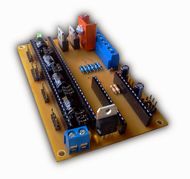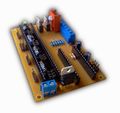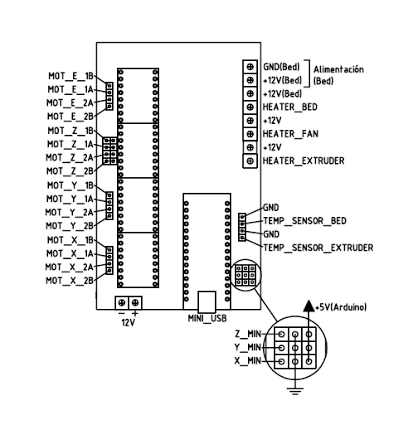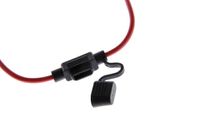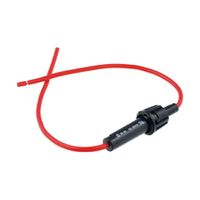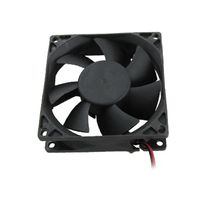SinapTec
|
English • العربية • български • català • čeština • Deutsch • Ελληνικά • español • فارسی • français • hrvatski • magyar • italiano • română • 日本語 • 한국어 • lietuvių • Nederlands • norsk • polski • português • русский • Türkçe • українська • 中文(中国大陆) • 中文(台灣) • עברית • azərbaycanca • |
SinapTec AT328.02 is a 3D FDM printer controller board of very low cost, its operation is based on an Arduino Nano running a version of Teacup_Firmware. The board layout is designed so that it can be manufactured by any hobbyist, it is a simple face plate with through-hole components.
Release status: Working
| Description | SinapTec AT328.02
3d printer controller board based on Arduino Nano.
|
| License | |
| Author | |
| Contributors | |
| Based-on | |
| Categories | |
| CAD Models | |
| External Link |
Contents
Summary
- 1 Arduino Nano socket.
- 4 Pololus sockets (X,Y,Z y E)
- 3 Line in for X_MIN, Y_MIN and Z_MIN endstops.
- 2 Line in for Hotend and heated bed sensors.
- 3 Mosfets outputs for Heater, Fan and Bed (this last with independent power supply).
Image Gallery
Bill of Materials (BOM)
| Amount | Code | Description |
|---|---|---|
| 3 | IRFZ44N-IR | TR. MOS-FET N-CH 50A 60V .028 E TO-220 |
| 3 | CR25M-10E | CARBON RESISTOR 1/4W 5% 10E |
| 3 | CR25M-100K | CARBON RESISTOR 1/4W 5% 100K |
| 4 | CR25M-1K8 | CARBON RESISTOR 1/4W 5% 1K8 |
| 2 | CR25M-4K7 | CARBON RESISTOR 1/4W 5% 4K7 |
| 3 | L3R | LED 3MM STANDARD RED 8MCD 60° |
| 1 | L3G | LED 3MM STANDARD GREEn 8MCD 60 |
| 1 | 1N4007 | DIODE RECTIFIER 1A 1000V |
| 2 | 10X50SR | CAP. ELECTROLITIC 10 X 50V RADIAL (5 X 11 MM) |
| 4 | 470X16SR | CAP. ELECTROLITIC 470 X 16V RADIAL (8 X 14MM) |
| 1 | LM7805 | REG. POSITIVO 5V 1.5A (10-220) |
| 2 | CER.1 | DISC CERAMIC CAPACITOR 100NF X 50V Y5V (P=2.5mm) |
| 5 | B2P | BORNE 2 POLOS APIL. 8A 300VAC AZUL |
| 12 | MJ2C | MINI JUMPER CORTO 6.5MM (CERRADO) |
| 1 | TP 1X40 | TIRA DE POSTES RECTA SIMPLE (1X40) .1" |
| 3 | TPHS1X40 | TIRA HEMBRA P/POSTE P/C.I. (1X40) .1" STANDARD |
Board Connection Diagram Pin Out
Warnings
Reversing +/- or otherwise incorrectly connecting power can destroy your electronics and cause fire hazard.
Incorrectly inserting stepper drivers will destroy your electronics and cause a fire risk. Always make sure power and USB is disconnected when removing or adjusting stepper drivers. Always make sure to insert drivers in correct orientation and in the socket correctly.
The endstop pins are Signal - GND - VCC, instead of the VCC - Sig - GND like the rest of RepRaps boards. Make sure to wire them correctly. This is done to allow squeezing fatter traces on the printable board.
DON'T secure SinapTec AT328.02 with conductive screws through both mounting holes. The screw may cut into the positive trace creating a HIGH current short.
Best Practices
A best practice is a technique or methodology that, through experience and research, has proven to reliably lead to a desired result.
- It higly recommended to place a fuse on power input of 5A and 10A for the bed.
| ATO / ATC Fuse | Cartridge Fuse |
|---|---|
- Active cooling over the electronics with a 80mm cooler is recommended.
| 12v 80mm Cooler |
|---|
Stepper Jumpers Configuration
The following table compares Made in China A4988 Stepper driver boards vs DRV8825 ones, for RepRap use:
| A4988 | DRV8825 | |
|---|---|---|
| Availability | very widely available | widely available |
| Approx. price | $6.80 / 5 pieces | $10 / 5 pieces |
| Max. theoretical current | 2A | 2.5A |
| Max. microsteps | 16 | 32 |
| PCB color | Green / Red | Purple |
| Stepper current adjust. trimpot | Yes, near Dir pin | Yes, near En pin |
| Typical Rs value | 0.05 Ohm or 0.1 Ohm or 0.2 Ohm |
0.1 Ohm |
| Vref formula (*) | I_TripMax= Vref/(8*Rs) | I_TripMax= Vref/(5*Rs) |
| Thermal Overload Protection (**) | Yes | Yes |
| PCB layers | 2 | 4 |
| Small heatsink included (***) | Almost always | Sometimes not |
| Active cooling required? | Recommended | Recommended |
| IC packaging | 5x5mm 28-lead QFN | 9.7x6.4mm 28HTSSOP |
Note that some important technical characteristics from the respective datasheets of the ICs are not directly comparable. For example, the DRV8825 is fully specified in terms of thermal characteristics, the A4988 is not. Another important characteristic that unfortunately is not directly comparable is RDSon, which is specified at different current levels in the respective IC datasheets.
(*) Adjusting the stepper driver current
See these instructions: Pololu_stepper_driver_board#Tuning_motor_current.
(**) Temperature Overload Protection
It is very important to keep the stepper driver ICs below a certain temperature during printing, since both ICs feature thermal overload protection that when triggered (typically when the die reaches a temperature of around 150~160 C), shuts down the output stages i.e. halts all commands to the affected stepper and in doing so, ruins the part being printed.
(***) Heatsinks
It is not yet determined how much of a real impact the small aluminum heatsinks shown in the pictures above have on cooling the ICs, as both stepper driver ICs depend much more on proper PCB layout and solder pad contact (as well as proper airflow, remember!) for heat dissipation, rather than on dissipation through the top of the IC package. This is because both stepper driver ICs have an exposed metal pad under the chip that contacts the PCB and this is the "path of least resistance" for heat dissipation. The secondary path for heat dissipation is through the package leads and in this aspect the DRV8825 provides for possibly slightly better power dissipation compared to the leadless A4988. It is my understanding that dissipation through the top of the ICs is almost irrelevant here.
Jumpers Configuration
- Jumpers need to be installed under each stepper driver:
| Jumper 1 | Jumper 2 | Jumper 3 | Step Size |
|---|---|---|---|
| No | No | No | Full Step |
| Yes | No | No | Half Step |
| No | Yes | No | 1/4 Step |
| Yes | Yes | No | 1/8 Step |
| Yes | Yes | Yes | 1/16 Step |
For now the default is 1/16 micro stepping (all jumpers installed under drivers)
Datasheets
Extra Files
PCB diagram for transfer toner
